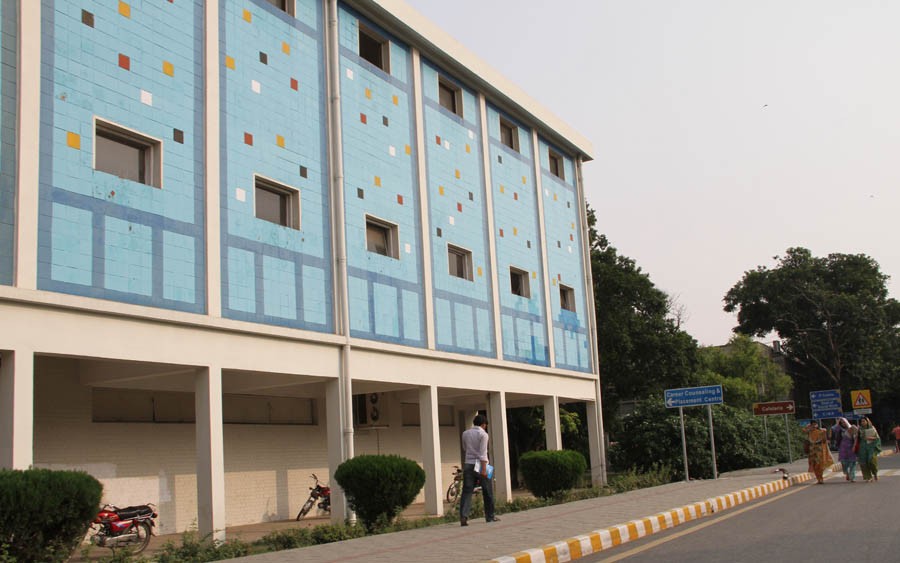
While the administration claims a much higher ranking for the University, academics question their claims

Following the recent clashes between the IJT and a group of Pashtun and Baloch students, the Punjab University has announced a plan to ensure discipline at the campus.
Preparations are underway to install biometric machines at the hostels to stop intruders. A blanket ban has been placed on holding any activity by students. The warning about rustication of students who resort to violence in future has also been issued once again.
The university management claims these measures are necessary as such activities have a negative impact on this institution’s reputation. They also term the violent attacks a show of frustration by the elements that are losing their control over the affairs of the university.
However, there are also those who term the steps taken by the university just cosmetic ones, taken with the aim to win top rankings. Their objection is that instead of focusing on the qualitative part, the university is depending on numbers and other faulty parameters set by the evaluation bodies.
Khurram Shahzad, spokesman of the Punjab University, claims that the introduction of foolproof and merit-based admission is one of the biggest achievements of the university. "The selection board today is represented by people from diverse backgrounds including experts from private sector universities and unlike in the past the academic degree has great weightage," he adds.
He says, "last year the Punjab University was ranked the second best university of the country by the Higher Education Commission (HEC) for meeting the required criteria."
Read also: Editorial
"The factors taken into account for ranking," says Shahzad, "include the publication of research material produced by the faculty in leading journal, the student-teacher ratio, the number of M Phil and Ph D faculty members, financial position on the institution and so on."
A faculty member at the university claims otherwise. He says "many a time applicants with masters degrees have been given preference over PhD and M Phil candidates for jobs of lecturers at different departments." The reason, he says, is that it is easy to control such faculty members who are dependent on the university to further their career and complete their M Phil and PhDs. "They cannot differ with the management on any issue as it would directly harm their interests," he adds.
He also questions the ranking criteria saying that the Punjab University has been put under the general category to get a high position on the chart. "This means that the agricultural universities, engineering universities etc are not considered while working out these rankings."
"Furthermore," he says, "the focus is on meeting the parameters set by ranking entities and not on bringing about improvement in real terms." An example he sites is about the number of students that falls in hundreds of thousands. "What actually happens is that the university affiliates institutes and colleges in every other street without ensuring fulfillment of proper criteria just to achieve numbers and earn money," he adds.
While the university sources claim no influence can be exerted during admissions, appointments and promotions, Dr Mehdi Hasan, former faculty of the university thinks otherwise. He states that "supporters of a particular organization, who were appointed in 1980s and 1990s are holding the positions of deans and directors at most of the departments. As they are part of the bodies that decide these matters their influence cannot be ruled out," he adds.
Hasan cites his own example and says he could not get promotion for 18 years just because his ideological alienation and thoughts were not acceptable to a particular group. He shares "he had to approach the court three times during his 31 years of service at the university to get his promotions that were simply denied to him."
Shahzad shares some facts that he claims make the university stand out among its competitors. "For example, the research funding has been increased from Rs4million in 2007-2008 to Rs110 million in 2015-16, a research endowment fund (started with Rs 250 million in 2010), currently at Rs600 million, also exists in addition to this funding. Funds for Faculty Development have been enhanced from Rs 45 million in 2007-2008 to Rs 75 million in 2015-16. This is in addition to the HEC funded faculty development programme."
He says, "under the two programmes over 100 faculty members have been sent abroad for doing PhD, of which many have returned and rejoined the faculty." This, he says, has increased the number of PhDs at the faculty-a major criteria for working out ranking.
He says the university’s financial strength is robust. It "manages 65 per cent of its budget of Rs 7.7 billion from its own sources and a major chunk comes from different fees deposited by students. The number of on-campus students as per the last fact book published by the university is 42,863 and that of off-campus students is 331,796. These include 132,807 students of affiliated colleges 198,989 private students."
The faculty member cited above is not impressed by these numbers. He says, "the question is that whether the university has won any major ranking from international ranking organisations or not and how many research publications have appeared in world class journals."
He says, unfortunately, the parameters set by local ranking entities are more about numerical values and less in terms of the quality and value-added to the education imparted there." Until there are any listings on their charts, he says, the rankings done by local organizations are misleading.
However, the spokesman of the university says this aspect is in their knowledge and the new administration has announced Rs1 million reward for each publication by any faculty member in Gold Star Research Journals. "Besides, approval for PU Medical College has been granted by the Punjab CM in addition to a Rs 50 million research grant from the Punjab Government."
This is a revised version of the article published in The News on Sunday on April 02, 2017.